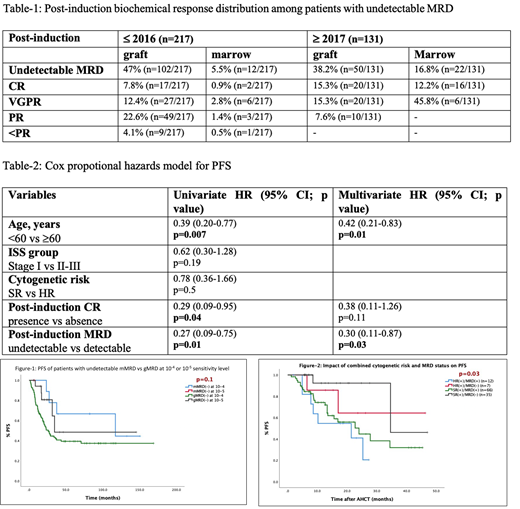Abstract
Introduction: Post-induction minimal residual disease (MRD) within but not outside (peripheral blood/stem cell graft) of marrow among transplant eligible patients with multiple myeloma (MM) is currently recognized as poor-prognostic. Emerging number of studies are evaluating MRD within the context of cytogenetic risk. In this study we aimed to quantify circulating plasma cells (PCs) by flow in apheresis products (graft=gMRD) and compare with marrow MRD(mMRD) and outcome according to cytogenetics.
Patients & Methods: Four hundred eleven subsequent newly diagnosed multiple myeloma (NDMM) patients transplanted (AHCT) between September 2006 - June 2021 were included prospectively. Standard-risk cytogenetics(SR) is defined as t(11;14), t(6;14), or a normal karyotype , whereas del(17p13), t(4;14), t(14;16), t(14;20), + 1q21 and complex findings are high-risk cytogenetics (HR). In the sample drawn for HPSC quantification of the graft and bone marrow, the number of clonal PCs were quantified by Flow. CD27 PC7 orCD27 A750, CD56 A700, CD19 ECD, CD38 FITC orCD38 A750, CD138 APC, CD45 KO, CD81 PE, CD117 PC7, polyclonal Rabbit Anti-Human Kappa or Lambda Chains /FITC antibodies and acquisition of at least 10 5 cells per tube Analysis was performed using the Navios Flow Cytometer (3L10C, Beckman Coulter) using the Kaluza software (Beckman Coulter, USA) according to the criteria defined by Montero et al and also abnormal distribution of kappa vs. Lambda expression. Undetectable MRD was defined as absence of clonal PCs at a sensitivity of 10 -4 prior to 2017(n=217) and 10 -5 after 2017(n=131). MRD assessment is similar in the graft and marrow. Impact of postinduction MRD analysis was performed in 131 patients with MRD data of 10 -5 sensitivity level. Results were reported in the intention-to-treat (ITT) population for mMRD.
Results: Median follow-up after AHCT was 61.5 months (range:3.2-168) (prior to 2017) and 17.7 months (range: 3-47.4) (after 2017). Induction regimen consisted of bortezomib without or with immunomodulatory drug (IMID) 78.8%, 2.8% (prior to 2017) and 74.1%, 22.9% (after 2017). Consolidation 18% (n=39/217), 22.1% (n=29/131) (prior and after 2017) and maintenance 21.2% (n=46/217), 35.1% (n=46/131) (prior and after 2017) were administered based on the response to AHCT. Cytogenetically HR was observed 14.1% (n=47) (among total cohort) and 15.8% (n=19) (after 2017 cohort). Post-induction biochemical response distribution among patients with undetectable MRD are shown in Table-1. MRD assessments were performed at a sensitivity of 10 -4 and 10 -5 in graft (n=147 and 76), marrow (n=18 and 4) or both (n=52 and 51). A statistically significant correlation was detected between marrow and graft MRD only at sensitivity level 10 -5 (SE: 0.638, p<0.001). Additionally, correlations between CR and gMRD (Kappa coefficient (SE): -0.284, p=0.03); CR and mMRD (SE: -0.452, p:0.001) were found. Since marrow and graft MRD results are correlated, all graft and marrow results were merged for the multivariate analysis (MVA) (Table-2). Having undetectable vs detectable MRD in either graft or marrow estimates a 2 years-PFS of 83.6% vs 46.5% (p=0.007). Among 42 MRD(-) patients, only four (two with HR)have relapsed. There is a tendency for better two year probability of PFS with undetectable mMRD vs gMRD at 10-5 ( not reached vs 84.7% ; ns)(Figure 1). The patients (after 2017) are divided into four groups according to MRD status and cytogenetic risk stratification: MRD(-)SR (n=35; 29.2%), MRD(-)HR (n=7; 5.8%), MRD(+)SR (n=66; 55%), MRD(+)HR (n=12; 10%). Kaplan-Meier curves revealed significant differences in PFS among these groups (p=0.03) (Figure-2).
Conclusion: Our real-world triplet drug induction-based experience shows for the first-time post-induction mMRD and MRD to be correlated with each other and with PFS. PFS with MRD(-) at 10 -5 results have displayed a better outcome compared to 10 -4. MVA showed MRD and age to determine PFS, independent from post-induction CR, ISS and cytogenetic risk. Although observed less frequently, achieving post-induction MRD(-) either in graft or marrow may ameliorate the poor prognosis of HR. With improvement in induction it may be possible to achieve more frequent MRD(-) and thus analyze the impact of each cytogenetics risk group ie 1q amplification separately. Furthermore, MRD in graft may be a non-invasive therapeutic efficacy tool which is subject to less sampling variation.
Beksac: Amgen,Celgene,Janssen,Takeda,Oncopeptides,Sanofi: Consultancy, Speakers Bureau.


This feature is available to Subscribers Only
Sign In or Create an Account Close Modal